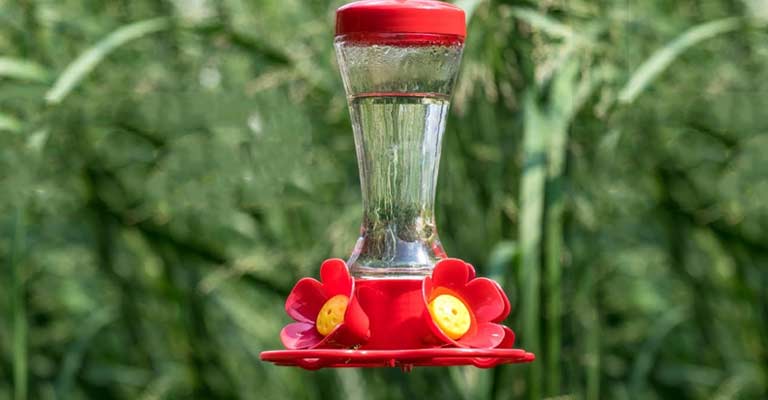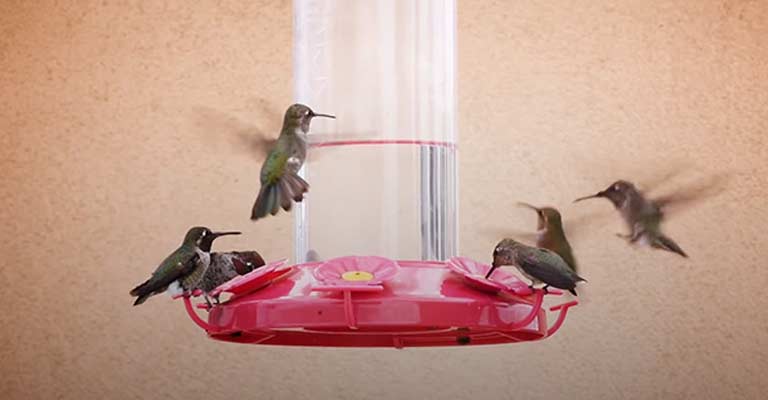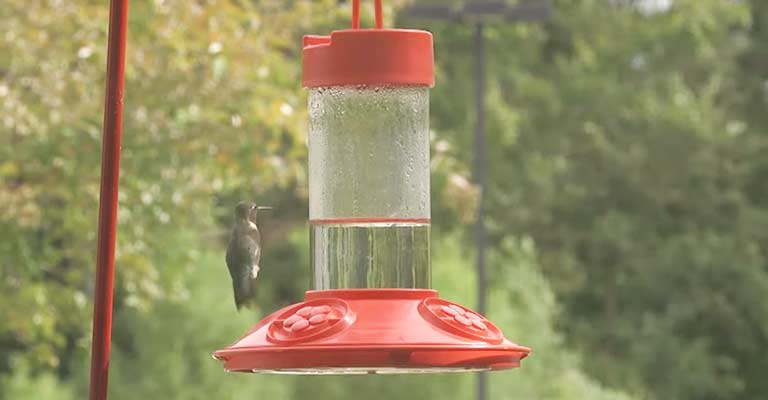The enchanting presence of hummingbirds in our gardens brings joy and wonder, and the provision of nectar-filled feeders is a gesture many enthusiasts undertake.
However, the perplexing issue of why does my hummingbird food get cloudy can disrupt this harmonious exchange. Cloudiness in the nectar, once crystal clear, sparks questions about its safety for these delicate avian visitors.
This phenomenon is not only an aesthetic concern but also holds implications for the health of the hummingbirds that depend on this sweet sustenance.
In unraveling the reasons behind the cloudiness, we delve into the delicate balance of sugar, water, cleanliness, and environmental factors that shape the clarity of the nectar, ultimately influencing the well-being of our winged companions.

Why Does My Hummingbird Food Get Cloudy?
Here’s why does your hummingbird food get cloudy:
Bacterial Growth
Hummingbird nectar can become cloudy due to the growth of bacteria. As the sugar-water solution sits in the feeder, especially in warm weather, it creates an environment conducive to bacterial development.
The presence of bacteria can cloud the nectar and potentially pose health risks to hummingbirds.
Fermentation
If the hummingbird food contains a higher concentration of sugar than recommended, fermentation may occur.
Fermentation is a natural process where sugars are converted into alcohol by yeast and bacteria. This can lead to cloudiness in the nectar and, more importantly, can be harmful to hummingbirds if consumed.
Exposure to Sunlight
Hummingbird feeders placed in direct sunlight for extended periods can experience quicker spoilage. Sunlight promotes the growth of microorganisms, leading to cloudiness in the nectar.
Using feeders with built-in UV protection or placing them in shaded areas helps mitigate this issue.
Lack of Cleaning
Inadequate cleaning of hummingbird feeders allows the accumulation of mold, dirt, and debris, leading to cloudy nectar. Regular cleaning is essential to prevent the growth of contaminants and maintain a clear, healthy nectar solution for hummingbirds.
Low-Quality Sugar
The type of sugar used in the hummingbird food can influence its clarity. Using impure or low-quality sugar may introduce particles and impurities that contribute to cloudiness.
Opting for high-quality, refined white sugar with no additives ensures a cleaner nectar solution.
Temperature Fluctuations
Drastic temperature changes, especially in regions with varying climates, can impact the clarity of hummingbird food. Rapid temperature fluctuations can lead to condensation inside the feeder, promoting the growth of microorganisms and causing cloudiness.
Placing feeders in stable, shaded locations helps minimize temperature-related issues.
Inadequate Filtering
Some hummingbird feeders come with inadequate or no filtration systems to prevent debris or insects from entering the feeder. Without proper filtration, particles and contaminants can enter the nectar, leading to cloudiness.
Upgrading to feeders with effective filtering mechanisms enhances the overall quality of the hummingbird food.
Hummingbird food can become cloudy due to bacterial growth, fermentation, exposure to sunlight, lack of cleaning, low-quality sugar, temperature fluctuations, and inadequate filtering.
Regular cleaning, using high-quality sugar, placing feeders strategically, and investing in well-designed feeders are crucial steps in maintaining clear and safe nectar for the delightful hummingbirds.
What To Do If My Hummingbird Food Gets Cloudy?

Here’s what to do if your hummingbird food gets cloudy:
Empty and Clean the Feeder
The first step to take if your hummingbird food becomes cloudy is to empty and thoroughly clean the feeder. Discard any remaining nectar and wash the feeder with a solution of one part white vinegar to four parts water.
Use a bottle brush to scrub the interior, including all components, and rinse thoroughly. Cleaning removes bacteria and contaminants that contribute to cloudiness.
Inspect for Mold or Debris
After cleaning, carefully inspect the feeder for any signs of mold, debris, or discoloration. If you notice mold or residue, repeat the cleaning process until the feeder is entirely free of contaminants.
Mold can be harmful to hummingbirds, so ensuring a pristine environment is crucial for their health.
Adjust Sugar-to-Water Ratio
Check and adjust the sugar-to-water ratio in your hummingbird food. A standard ratio is four parts water to one part white granulated sugar. Using too much sugar can lead to fermentation and cloudiness.
By adhering to the recommended ratio, you provide a balanced and safe nectar solution for hummingbirds.
Use High-Quality Sugar
Ensure you are using high-quality, refined white sugar with no additives. Lower-quality sugars or those with impurities can contribute to cloudiness. Opting for a pure sugar source enhances the clarity of the nectar and provides a cleaner and healthier environment for the hummingbirds.
Move the Feeder to the Shade
If your feeder is exposed to direct sunlight for extended periods, consider moving it to a shaded area. Sunlight accelerates the growth of microorganisms, leading to cloudiness.
Placing the feeder in a shaded spot helps mitigate bacterial development and preserves the clarity of the hummingbird food.
Install a Feeder with UV Protection
Invest in a hummingbird feeder with built-in UV protection. UV-resistant materials help prevent sunlight degradation and maintain the clarity of the nectar.
These feeders are designed to withstand outdoor conditions and provide a more stable environment for the hummingbird food.
Regular Maintenance and Rotation
Establish a routine for regular maintenance and rotation of your hummingbird feeders. Clean the feeders at least once every few days, even in cooler weather, to prevent bacterial growth.
Additionally, consider having multiple feeders that you can rotate. This allows for thorough cleaning and drying between uses, reducing the likelihood of cloudiness.
If your hummingbird food becomes cloudy, take immediate action by emptying and cleaning the feeder, inspecting for mold or debris, adjusting the sugar-to-water ratio, using high-quality sugar, moving the feeder to shade, installing a feeder with UV protection, and implementing a routine for regular maintenance and rotation.
These proactive steps ensure a clear and safe nectar solution, promoting the health and well-being of the delightful hummingbirds in your area.
How Do I Prevent My Hummingbird Food From Getting Cloudy?

Let’s discuss how do you prevent my hummingbird food from getting cloudy:
Regular Cleaning Routine
Establishing a regular cleaning routine is crucial in preventing your hummingbird food from becoming cloudy. Clean the feeder at least every few days, even in cooler weather, using a solution of one part white vinegar to four parts water.
Thoroughly scrub the interior and all components with a bottle brush, ensuring the removal of any potential contaminants. Regular cleaning prevents the buildup of bacteria and mold, maintaining a clean and healthy nectar solution for hummingbirds.
Proper Sugar-to-Water Ratio
Ensure you use the correct sugar-to-water ratio when preparing hummingbird food. The recommended ratio is four parts water to one part white granulated sugar.
Using too much sugar can lead to fermentation and cloudiness. By following the appropriate proportions, you provide a balanced and safe nectar solution for hummingbirds, minimizing the risk of bacterial growth.
High-Quality Sugar Selection
Choose high-quality, refined white sugar with no additives for your hummingbird food. Lower-quality sugars or those with impurities can contribute to cloudiness.
Opting for a pure sugar source enhances the clarity of the nectar and creates a cleaner and healthier environment for the hummingbirds to feed.
Shaded Feeder Placement
Position your hummingbird feeder in a shaded area to prevent excessive exposure to sunlight.
Direct sunlight can accelerate the growth of microorganisms, leading to cloudiness. Placing the feeder in a shaded spot helps mitigate bacterial development and preserves the clarity of the hummingbird food.
Invest in UV-Resistant Feeders
Consider investing in hummingbird feeders made from UV-resistant materials. These feeders are designed to withstand the degrading effects of sunlight, maintaining their structural integrity and preventing cloudiness in the nectar.
UV-resistant feeders provide a more stable environment for the hummingbird food, extending its clarity.
Use Fresh Ingredients
Always use fresh and clean ingredients when preparing hummingbird food. Ensure that both the water and sugar are of high quality and free from any contaminants.
Starting with fresh ingredients reduces the likelihood of introducing impurities that could contribute to cloudiness in the nectar.
Rotate and Inspect Feeders
Implement a rotation system for multiple hummingbird feeders. This practice allows you to regularly inspect, clean, and dry each feeder between uses.
By rotating the feeders, you minimize the potential for bacterial growth and ensure a consistently clear nectar solution for the hummingbirds to enjoy.
Preventing your hummingbird food from becoming cloudy involves maintaining a regular cleaning routine, adhering to the proper sugar-to-water ratio, selecting high-quality sugar, placing feeders in shaded areas, investing in UV-resistant feeders, using fresh ingredients, and implementing a rotation system.
These proactive measures collectively contribute to a clean, safe, and inviting environment for the delightful hummingbirds in your vicinity.
FAQs
Why does my hummingbird food become cloudy?
Hummingbird food can become cloudy due to bacterial growth, fermentation, exposure to sunlight, lack of regular cleaning, low-quality sugar, temperature fluctuations, and inadequate filtration. These factors contribute to the degradation of the nectar, impacting its clarity and potentially posing health risks to hummingbirds.
Can cloudy hummingbird food harm the hummingbirds?
Yes, cloudy hummingbird food can pose health risks to hummingbirds. Bacterial growth and fermentation in the nectar can be harmful if consumed. Maintaining a clear and clean nectar solution is crucial to ensuring the well-being of these delicate avian visitors.
How can I prevent my hummingbird food from getting cloudy?
Prevent cloudiness in hummingbird food by establishing a regular cleaning routine, using the correct sugar-to-water ratio, selecting high-quality sugar, placing feeders in shaded areas, investing in UV-resistant feeders, using fresh ingredients, and rotating multiple feeders.
Does the type of sugar used affect nectar clarity?
Yes, the type of sugar used affects nectar clarity. Using high-quality, refined white sugar with no additives is crucial. Lower-quality sugars or those with impurities can contribute to cloudiness. Opting for a pure sugar source enhances the clarity of the nectar and creates a cleaner environment for hummingbirds.
What role does sunlight play in the cloudiness of hummingbird food?
Sunlight accelerates the growth of microorganisms in hummingbird food, leading to cloudiness. Placing feeders in direct sunlight for extended periods can promote bacterial development.
Positioning feeders in shaded areas helps mitigate this issue and preserves the clarity of the hummingbird food.
Conclusion
In the world of hummingbird enthusiasts, the mystery of cloudy hummingbird food finds resolution through proactive measures and an understanding of the delicate ecosystem within the feeder.
From meticulous cleaning routines to the quality of sugar used, every factor plays a role in maintaining a pristine environment for these tiny, vibrant creatures. The journey to clarity involves not only rectifying cloudiness but also safeguarding the health and vitality of hummingbirds.
As stewards of this miniature ecosystem, our commitment to transparency in the nectar is a testament to our dedication to the well-being of the hummingbirds that grace our gardens with their fleeting beauty.